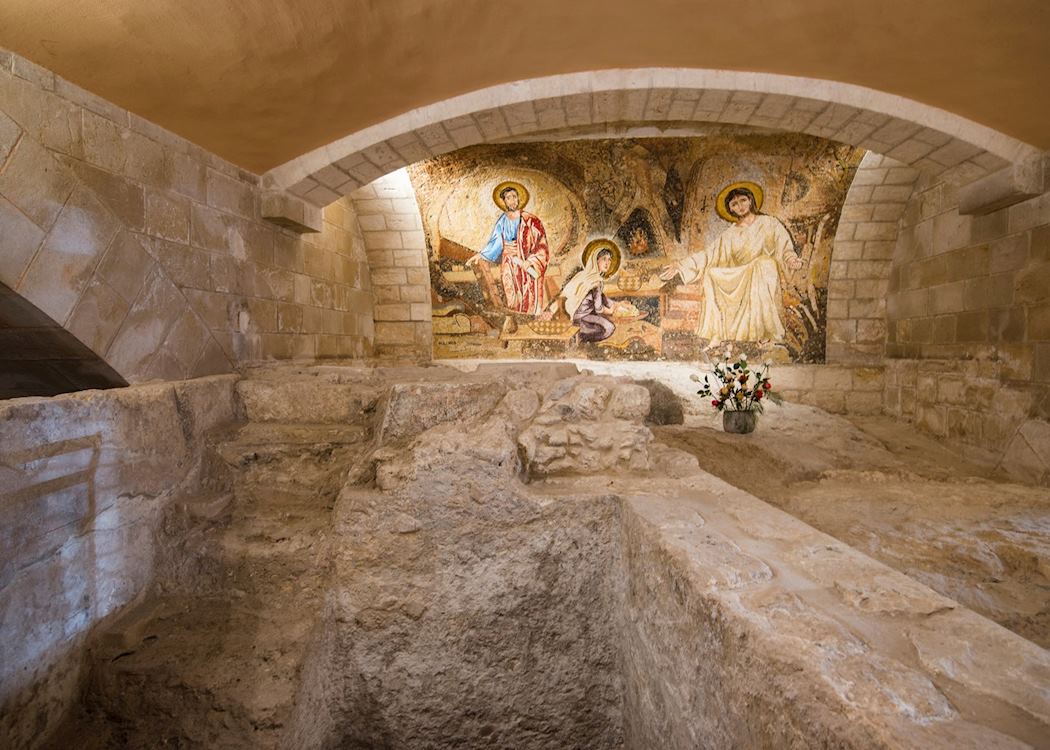

The upper level contains a number of images of Mary, mainly mosaics, each from a different country with significant Catholic population. The lower level contains the Grotto of the Annunciation, believed by many Christians to be the remains of the original childhood home of Mary. The current Catholic Church is a two-storey building finished in 1969 over the site of earlier churches from the Byzantine, Crusader, and the Israeli -period churches. A historically significant site, considered sacred within some circles of Christianity, particularly Catholicism, the basilica attracts many Catholic, Anglican, and Eastern Orthodox Christian visitors every year.

Under Canon Law, the church enjoys the status of a minor basilica. Pope John Paul II made a pilgrimage to the Holy Land for the Great Jubilee of 2000 and celebrated Mass at the Basilica of the Annunciation on March 25, 2000. It is the largest Christian Church building or sanctuary in the Middle East under the supervision of the Congregation for the Oriental Churches. Used by the Latin parish, it remains under the control of the Franciscans. Pope Paul VI celebrated Mass in the new church during his trip to the Holy Land in 1964 The basilica was completed in 1969. It is built in a style sometimes characterised as Italian Brutalism. Shlomo Lopatin (Aluf) who was dedicated to the Basilica building process for more than 10 years, and it was indeed his life-project. The Chief Engineer at this project was Ing. The new basilica was designed by the Italian architect Giovanni Muzio, and built by the Israeli building firm Solel Boneh during the years 1960–1969. The old church was completely demolished in 1954 to allow for the construction of a new basilica. In 1730, Dahir al-Umar permitted construction of a new church, which became a central gathering place for Nazareth Latin community. Įmir Fakhr ad-Din granted the Franciscans permission to return to Nazareth and the church ruins in 1620, at which time they constructed a small structure to enclose the holy grotto that is venerated as the house of Mary. In 1260, Baybars and his Mamluk army destroyed the church during their attack on Nazareth. Saladin granted permission to Franciscan priests to remain in Nazareth to oversee services at the church. Five Romanesque capitals carved by artists from northern France, and discovered during excavations in 1909, had not yet been installed in 1187 when news of Saladin's victory in the Battle of Hittin reached the city. The Crusader-era church was never fully completed. The second church was built over the ruins of the Byzantine-era church during the Crusades, following the conquest of Nazareth by Tancred in 1102. Ī competing view is that the Church was the site of the Holy House, which, according to Catholic legend, was transported by angels across the sea to Loreto, Italy, at the time of the Muslim conquest. Some version of it was known to have still been in existence around 570. The Church of the Annunciation was founded around the same time as the Church of the Nativity (the birthplace) and the Church of the Holy Sepulchre (the tomb). Another tradition, based on the apocryphal Protoevangelium of James, holds that this event commenced while Mary was drawing water from a local spring in Nazareth, and the Greek Orthodox Church of the Annunciation was erected at that alternate site.Ĭhristian tradition has held that a structure was commissioned by Emperor Constantine I, whose mother, Saint Helena, helped to found churches commemorating important events in Jesus Christ's life. The church was established at the site where, according to one tradition, the Annunciation took place.

It was established over what Catholic tradition holds to be the site of the house of the Virgin Mary. It is one of two claimants to the site of the Annunciation – in which angel Gabriel appeared to the Virgin Mary and announced that she would give birth to Jesus – the other being the Greek Orthodox Church of the Annunciation. The Church of the Annunciation ( Latin: Basilica Annuntiationis, Arabic: كنيسة البشارة, Hebrew: כנסיית הבשורה), sometimes also referred to as the Basilica of the Annunciation, is a Catholic church in Nazareth, in northern Israel. For other uses, see Church of the Annunciation. This article is about the Catholic basilica in Nazareth.


 0 kommentar(er)
0 kommentar(er)
